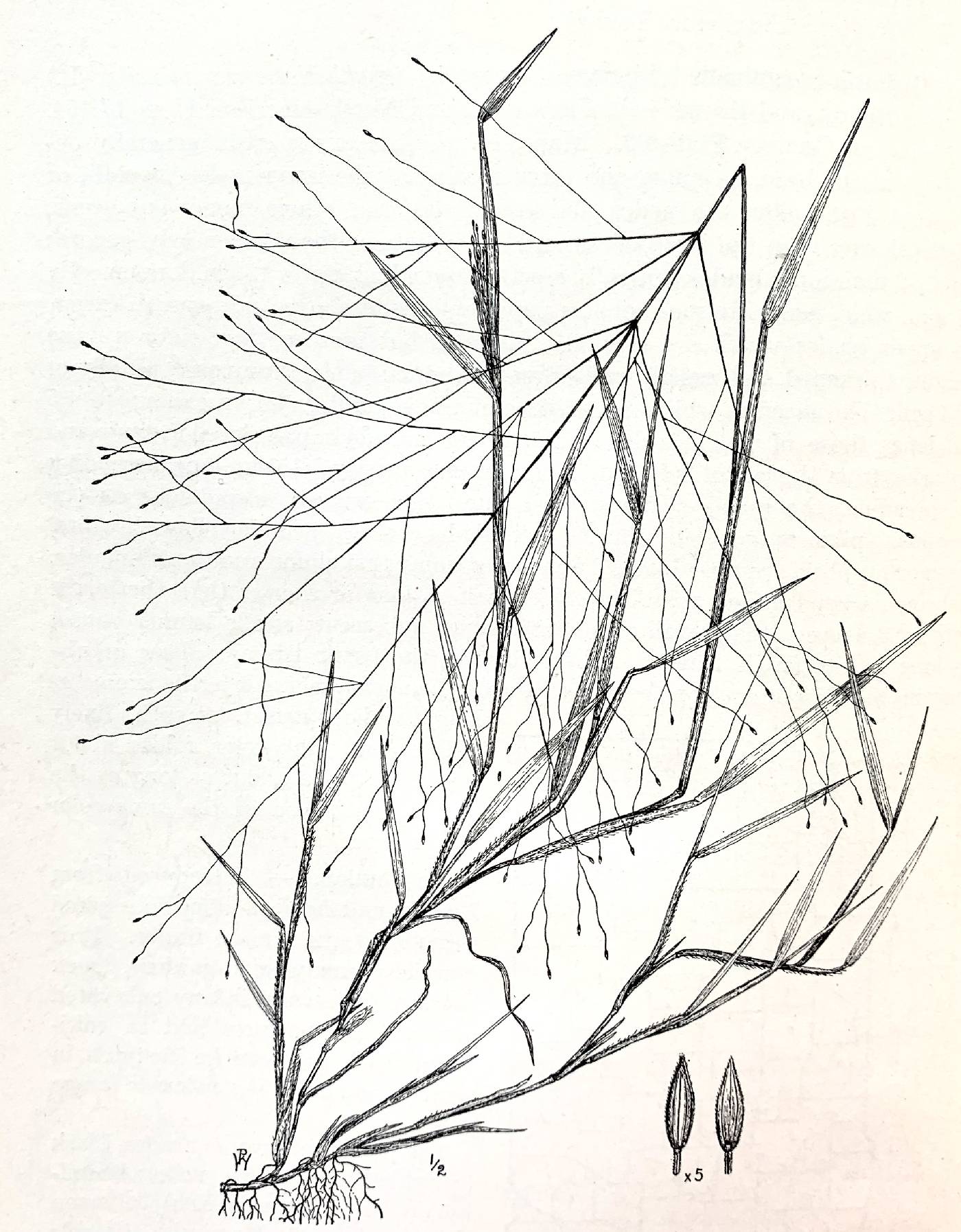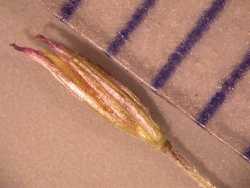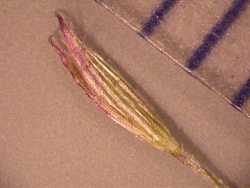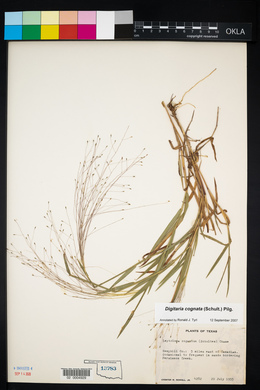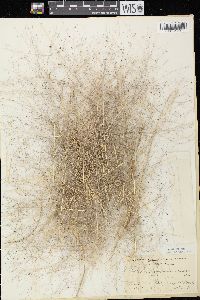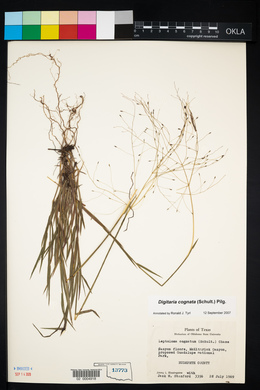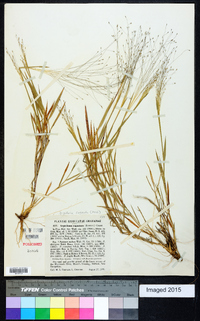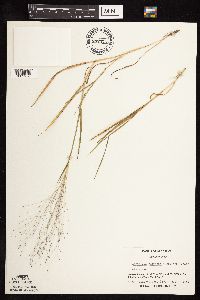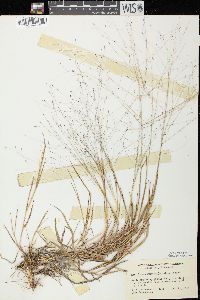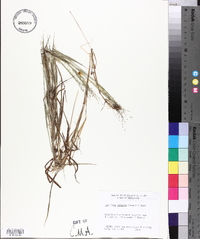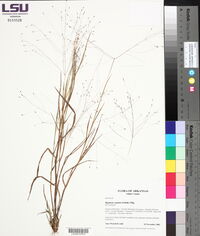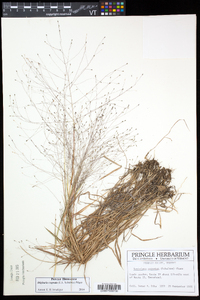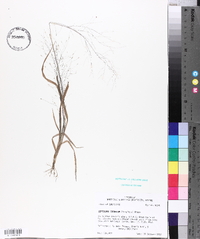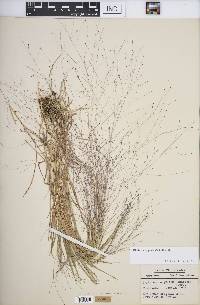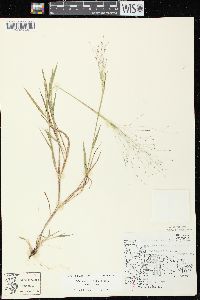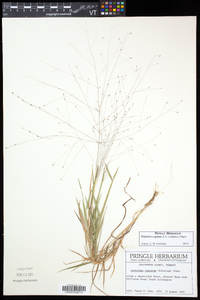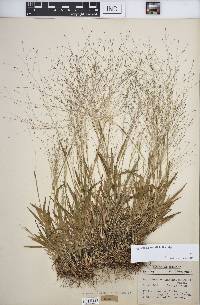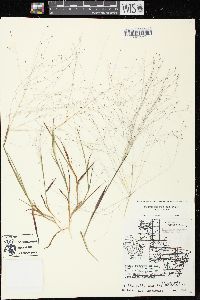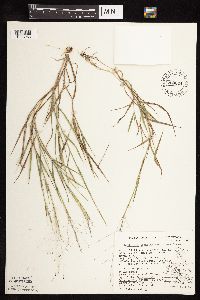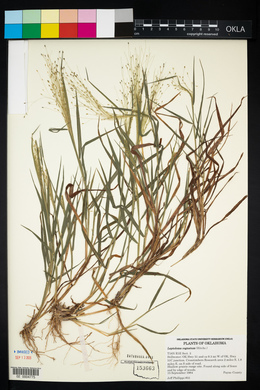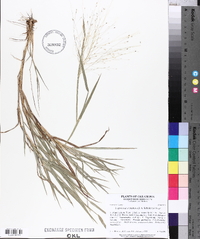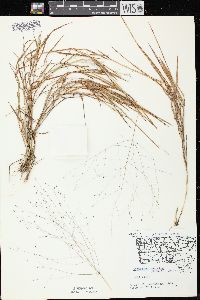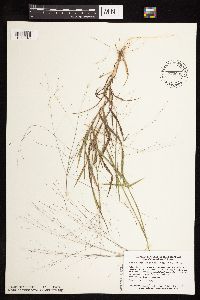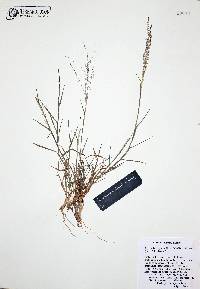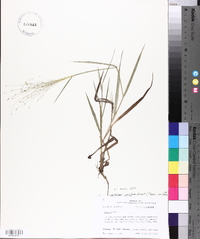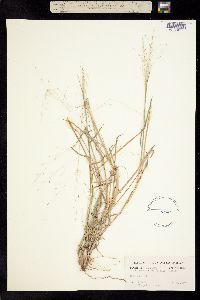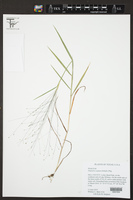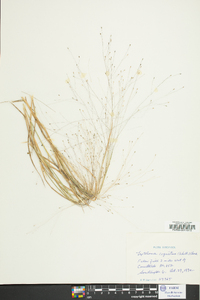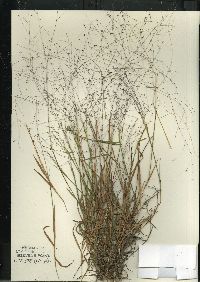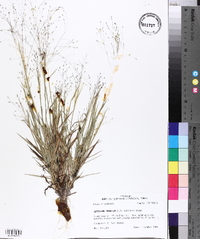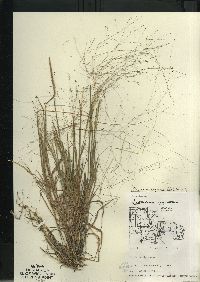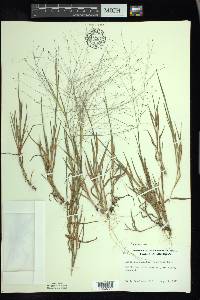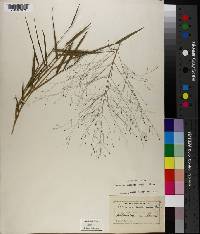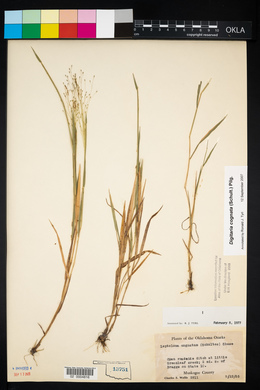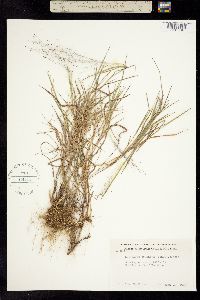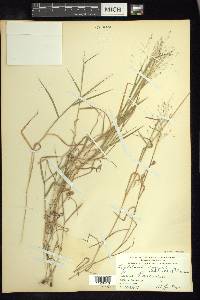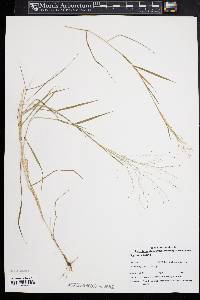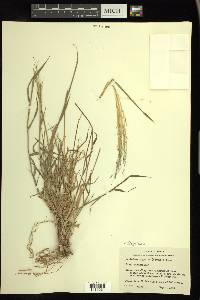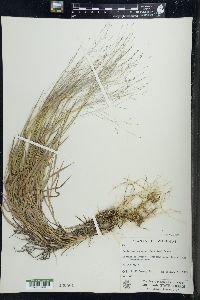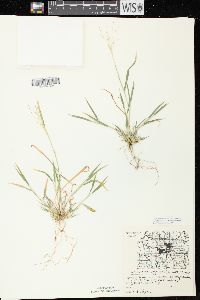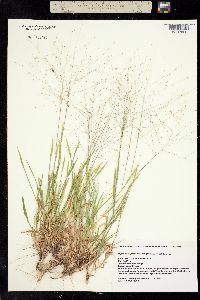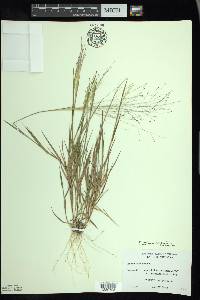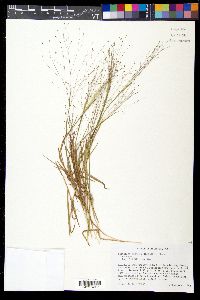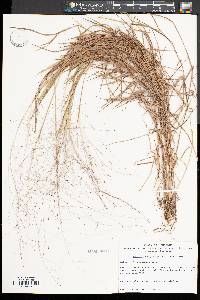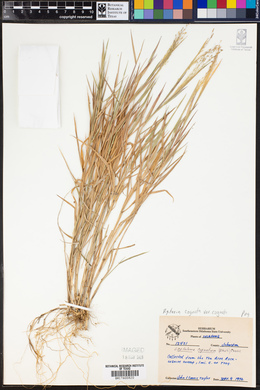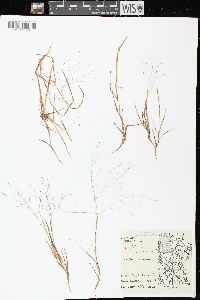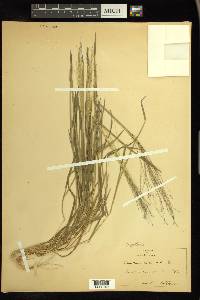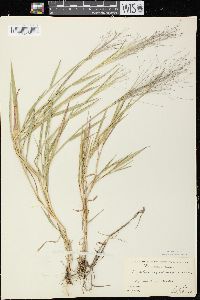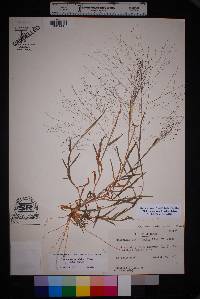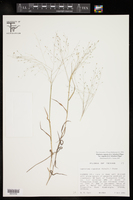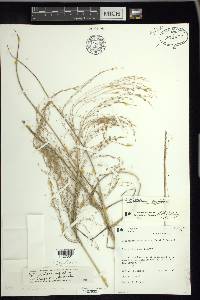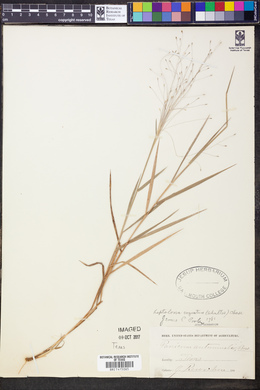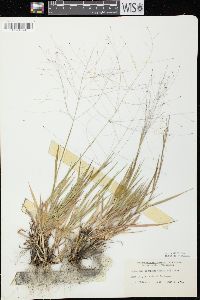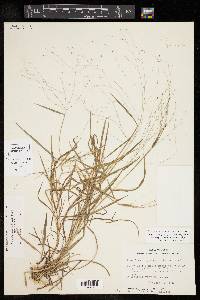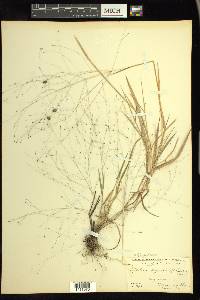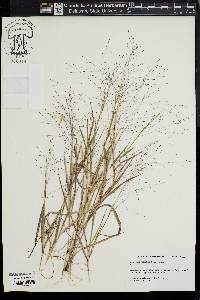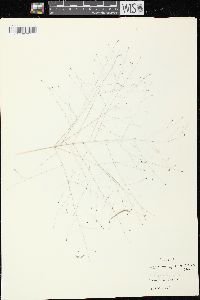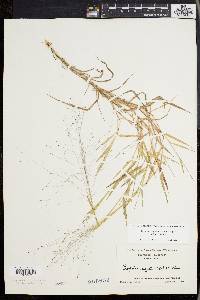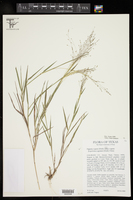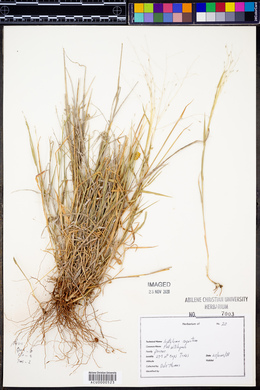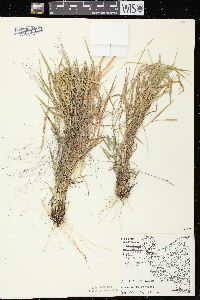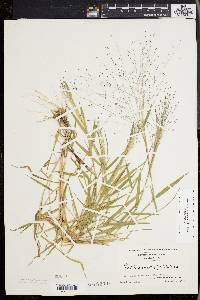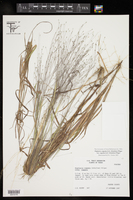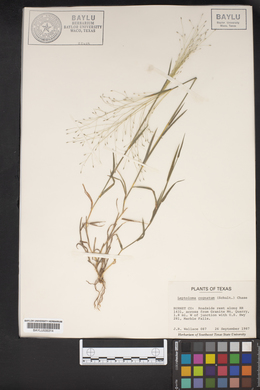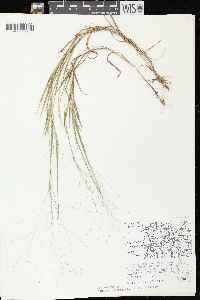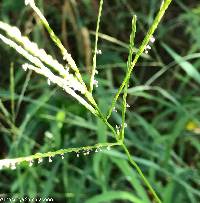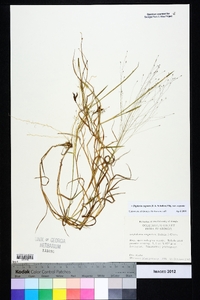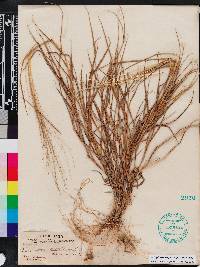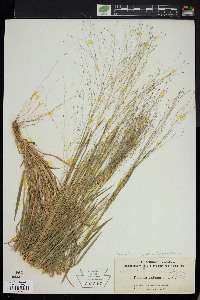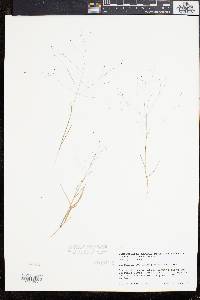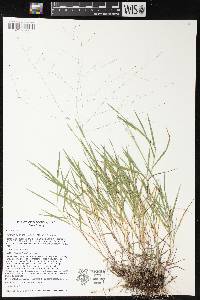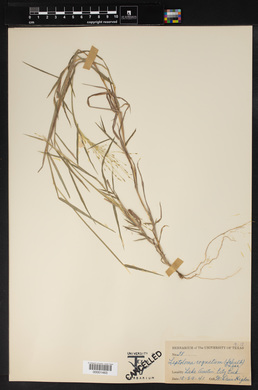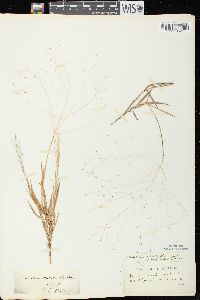
|
|
|
|
Family: Poaceae
Carolina Crab Grass, more...Carolina cottontop, Carolina crabgrass, Fall Witchgrass
[Digitaria cognata subsp. cognata, moreLeptoloma cognata , Leptoloma cognata var. cognata , Leptoloma cognatum (Schult.) Chase, Leptoloma cognatum var. cognatum , Panicum autumnale Bosc ex Spreng., Panicum cognatum Schult., Panicum fragile Kunth, Panicum nudum Walter] |
Plants perennial; cespitose, without rhizomes. Culms 30-56 cm, erect; nodes glabrous. Leaves mainly cauline; sheaths glabrous or sparsely to densely pubescent, sometimes with papillose-based hairs; ligules 0.2-1.5 mm, entire to lacerate; blades 2.4-12.6 cm long, 2-5.4 mm wide, glabrous or pubescent. Panicles simple, 12.8-27.5 cm long, 16.5-44.5 cm wide, open; branches divergent; lower primary branches 10.5-24 cm, often with 1-several sterile branches near the base; pedicels divergent, spikelets solitary. Spikelets 2.2-3.1 mm long, 0.7-1.1 mm wide, obovate or broadly elliptic. Lower glumes 0.1-0.8 mm; upper glumes 1.8-2.8 mm, 3(5)-veined, glabrous or pubescent between the veins, hairs appearing as a narrow stripe; lower lemmas similar to the upper glumes in length, texture, and pubescence, 7-veined, veins unequally spaced, lateral veins closer together than the 3 central veins; upper lemmas 1.9-2.9 mm, glabrous, dark brown, narrowly acute; anthers 0.5-0.7 mm, yellow or purple. Caryopses 1.3-1.6 mm. 2n = 36. Digitaria cognata grows in dry, sandy soils in the eastern portion of the Flora region, from southern Ontario and Vermont through the United States and thence to southern Mexico. Perennial herb, tufted 30 cm - 0.5 m tall Leaves: alternate, two-ranked. Sheaths open, sometimes sparsely to densely hairy. Ligules to 1.5 mm long, membranous. Blades 2.5 - 12.5 cm long, 2 - 5.5 mm wide, flat, parallel-veined, sometimes hairy. Inflorescence: a terminal, branched arrangement of spikelets (panicle), open, 12.5 - 27.5 cm long, 16.5 - 44.5 cm wide. Branches divergent. Fruit: a caryopsis, indehiscent, enclosed within the persistent lemma and palea, flat on one side and convex on the other (plano-convex). Culm: upright, 30 cm - 0.5 m long, round in cross-section. Spikelets: solitary, 2 - 3 mm long, 0.5 - 1 mm wide, broadly elliptic or reverse egg-shaped. Florets: two per spikelet. Lower florets sterile. Upper florets bisexual. Anthers three, purple or yellow, about 0.5 mm long. Stigmas red. Glumes:: Lower glumes 0.1 - 0.8 mm long. Upper glumes 2 - 2.5 mm long, three- to five-veined, sometimes hairy between the veins (hairs appearing as a thin stripe). Lemmas:: Lower lemmas similar to upper glumes in length, texture, and hairiness, equal to upper lemmas, seven-veined (unequally spaced), membranous. Upper lemmas brown, 2 - 3 mm long, narrowly pointed at the apex, obscurely veined, with margins that embrace the upper paleas. Paleas:: Lower paleas absent. Upper paleas similar in size and texture to upper lemmas. Similar species: No information at this time. Flowering: July to September Habitat and ecology: Sandy areas. Occurence in the Chicago region: native Etymology: Digitaria comes from the Latin word digitus, meaning finger, referring to the digitate inflorescence of some species. Cognata means "closely related," for Schultes thinking it was close to Panicum capillare. Author: The Morton Arboretum FNA 2003, Gould 1980 Common Name: fall witchgrass Duration: Perennial Nativity: Native Lifeform: Graminoid General: Caespitose perennial grass, without rhizomes; stems erect, 30-60 cm, with glabrous nodes. Vegetative: Sheaths glabrous or sparsely to densely pubescent; ligule 0.2-1.5 mm, entire to lacerate; blades 2-13 cm long, 2-6 mm wide, glabrous or pubescent. Inflorescence: Simple, open panicles, 10-30 cm long, 15-45 cm wide; branches diverging, the lowest with 1-several sterile branches near base; divergent pedicels with solitary spikelets; spikelets 2-3 mm long, to 1 mm wide, obovate or broadly elliptic, with 2 florets, the lower floret sterile and the upper floret fertile; disarticulation below the glumes; lower glumes less than 1 mm long; upper glumes 1.5-3 mm, 3-veined, glabrous or pubescent between veins, hairs look like a narrow stripe; lower lemmas similar to upper glumes, 7-veined; upper lemmas 3 mm, glabrous, dark brown, narrowly acute. Ecology: Dry, sandy soils, rocky slopes and plains; 2,500-5,500 ft (762-1676 m); flowers May-November. Distribution: Much of the eastern half of the US and west to AZ; south to s MEX. Notes: Distinguished by being a perennial with a whispy, almost invisible open panicle with widely spaced, solitary, flattened, single-flowered spikelets 2-3 mm long, sometimes with short, white pubescence between veins. The basal branches of the inflorescence are usually concealed and emerging from leaf sheaths. Digitaria pubiflora has been treated as a separate species in some treatments but has been merged and is here included in D. cognata. Appears similar to many Panicum spp, but Digitaria is distinguished from Panicum by its first glumes, which are absent or less than 1/4 the length of the second glumes. Ethnobotany: The seeds were ground into a meal and eaten. Etymology: Digitaria is from Latin digitus, a finger, while cognata means closely related to, think cognate. Synonyms: Leptoloma cognatum, Panicum cognatum Editor: SBuckley 2010, FSCoburn 2014, AHazelton 2015 Culms tufted and sometimes shortly rhizomatous, 4-7 dm; lower sheaths villous to papillose-hirsute; blades 5-10 cm נ2-6 mm; panicle diffusely branched, often a third to half the height of the plant, purplish, villous in the axils; pedicels 1-4 cm, 3-angled, scabrous; spikelets narrowly elliptic, acute, 2.5-3.5 mm, the second glume and sterile lemma commonly pubescent between the veins, the hairs spreading at maturity; 2n=36, 72. Dry, especially sandy soil; se. U.S. and n. Mex., n. to Nebr., Minn., s. Mich., s. Ont., Va., and irregularly to N.H. (Digitaria c.) Gleason, Henry A. & Cronquist, Arthur J. 1991. Manual of vascular plants of northeastern United States and adjacent Canada. lxxv + 910 pp. ©The New York Botanical Garden. All rights reserved. Used by permission. From Flora of Indiana (1940) by Charles C. Deam This grass is found in very sandy soil on sand ridges and sandy knolls, usually in fallow fields, along roadsides, and in open woodland. ...... Indiana Coefficient of Conservatism: C = 2 Wetland Indicator Status: n/a |

